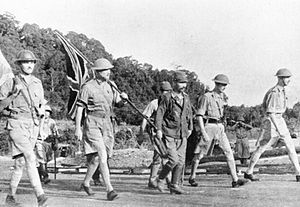
Back معركة سنغافورة Arabic Batalla de Singapur AST سنقاپور دؤیوشو AZB Сингапурска битка Bulgarian Emgann Singapour Breton Batalla de Singapur Catalan Bitva o Singapur Czech Slaget om Singapore Danish Schlacht um Singapur German Batalo de Singapuro Esperanto
| Battle of Singapore | |||||||||
|---|---|---|---|---|---|---|---|---|---|
| Part of the Pacific War of the Second World War | |||||||||
 Lieutenant-General Arthur Percival (right), led by Ichiji Sugita, walks under a flag of truce to negotiate the capitulation of Commonwealth forces in Singapore, 15 February 1942. | |||||||||
| |||||||||
| Belligerents | |||||||||
|
| |||||||||
| Commanders and leaders | |||||||||
| Units involved | |||||||||
|
| |||||||||
| Strength | |||||||||
|
85,000 troops 300 guns 1,800+ trucks 200 AFVs 208 anti-tank and anti-aircraft guns 54 fortress guns[a][b] |
36,000 troops 440 artillery pieces[4] 3,000 trucks[5] | ||||||||
| Casualties and losses | |||||||||
|
c. c. 80,000 wounded and captured |
1,714 killed 3,378 wounded | ||||||||
The fall of Singapore, also known as the Battle of Singapore,[c] took place in the South–East Asian theatre of the Pacific War. The Japanese Empire captured the British stronghold of Singapore, with fighting lasting from 8 to 15 February 1942. Singapore was the foremost British military base and economic port in South–East Asia and had been of great importance to British interwar defence strategy. The capture of Singapore resulted in the largest British surrender in history.
Before the battle, Japanese General Tomoyuki Yamashita had advanced with approximately 30,000 men down the Malayan Peninsula in the Malayan campaign. The British erroneously considered the jungle terrain impassable, leading to a swift Japanese advance as Allied defences were quickly outflanked. The British Lieutenant-General, Arthur Percival, commanded 85,000 Allied troops at Singapore, although many units were under-strength and most units lacked experience. The British outnumbered the Japanese but much of the water for the island was drawn from reservoirs on the mainland. The British destroyed the causeway, forcing the Japanese into an improvised crossing of the Johore Strait. Singapore was considered so important that Prime Minister Winston Churchill ordered Percival to fight to the last man.
The Japanese attacked the weakest part of the island defences and established a beachhead on 8 February. Percival had expected a crossing in the north and failed to reinforce the defenders in time. Communication and leadership failures beset the Allies and there were few defensive positions or reserves near the beachhead. The Japanese advance continued and the Allies began to run out of supplies. By 15 February, about a million civilians in the city were crammed into the remaining area held by Allied forces, 1 percent of the island. Japanese aircraft continuously bombed the civilian water supply which was expected to fail within days. The Japanese were also almost at the end of their supplies and Yamashita wanted to avoid costly house-to-house fighting.
For the second time since the battle began, Yamashita demanded unconditional surrender and on the afternoon of 15 February, Percival capitulated. About 80,000 British, Indian, Australian and local troops became prisoners of war, joining the 50,000 taken in Malaya; many died of neglect, abuse or forced labour. Three days after the British surrender, the Japanese began the Sook Ching purge, killing thousands of civilians. The Japanese held Singapore until the end of the war. About 40,000, mostly conscripted, Indian soldiers joined the Indian National Army and fought with the Japanese in the Burma campaign. Churchill called it the worst disaster in British military history. The fall of Singapore, the sinking of Prince of Wales and Repulse, and other defeats in 1941–42 all severely undermined British prestige, which contributed to the end of British colonial rule in the region after the war.
- ^ Allen 2013, pp. 300–301.
- ^ Blackburn & Hack 2004, p. 74.
- ^ Blackburn & Hack 2004, p. 193.
- ^ Allen 2013, p. 169.
- ^ Toland 2003, p. 272.
Cite error: There are <ref group=lower-alpha> tags or {{efn}} templates on this page, but the references will not show without a {{reflist|group=lower-alpha}} template or {{notelist}} template (see the help page).